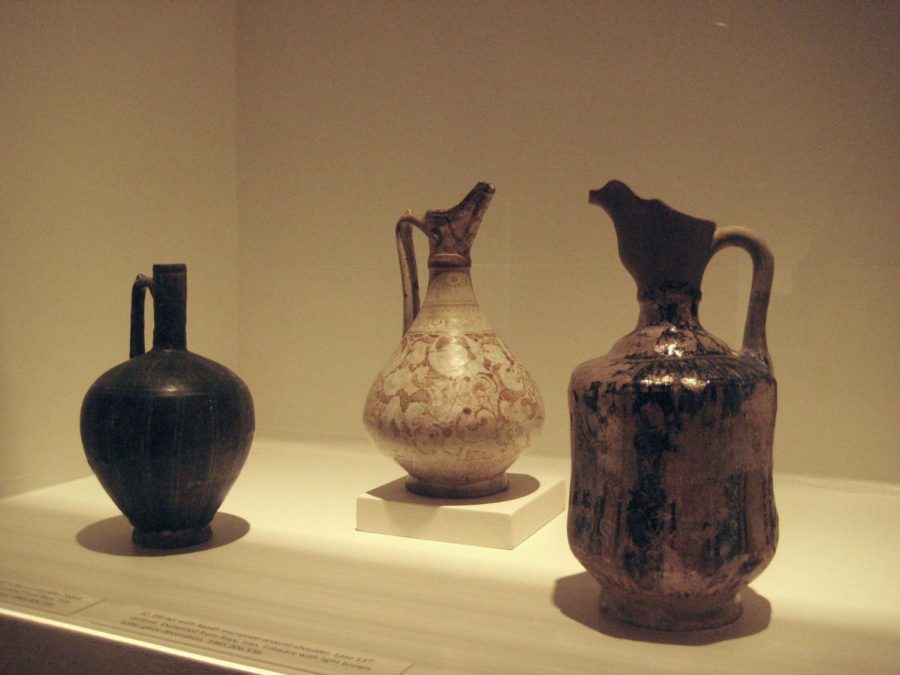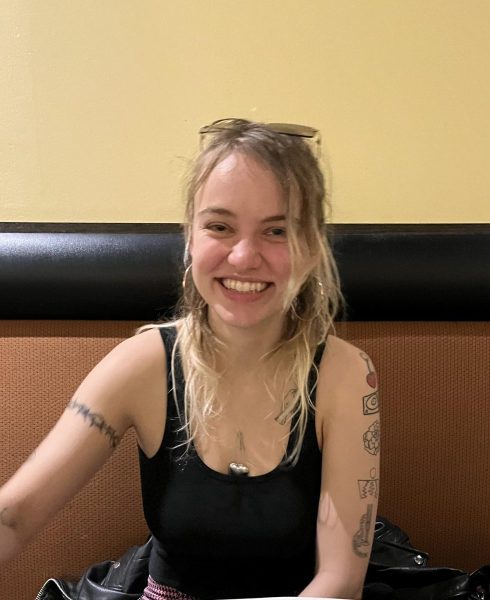“Fragmentary Visions” showcases work from the past millennium and beyond
Left to right: Silhouette-Ware Ewer with Nashki script on shoulder. Late 12th – early 13th century, Iran. Fritware with black slip under turquoise glaze. Pitcher with Naskh inscription around shoulder. Late 13th century, Iran. Fritware with light brown luster glaze decoration. Ewer. Late 12th century, Syria. Fritware, underglaze blue and turquoise with luster over transparent glaze.
February 27, 2023
This semester, four students in the ARH-360: Exhibition Seminar art history class hand-picked international ceramics, textiles and manuscripts ranging from the 13th through the 19th century to highlight in their exhibition “Fragmentary Visions: Grinnell’s Kelekian Collection,” currently on display at the Grinnell College Museum of Art through May 6. Assistant Professor of Art History Eiren Shea’s class, composed of Marina Busby `24, David Gales `23, Melena Johnson `23 and Lâl Verda Karaoĝlu `25, organized this exhibit, writing essays to accompany the curation.
“We wanted to show our objects as they are in their truest form — fragmented and a little dirty,” Karaoĝlu said. In naming the show “Fragmentary Visions,” the students celebrated the imperfection of the pieces instead of the industry standard of gluing them together to imitate the aesthetic of an original condition, Karaoĝlu said.
“They are not perfect by any means — textiles have fingerprints, the ceramics have cracks that have been painted over, the books have annotations in them. Hence, the word ‘fragmentary’ — because they are not only fragmented, but also fragments of history.”
Additionally, Karaoĝlu said that the name is free of historical connotations and attributes, not restricting itself to a single region or time period, so it can stand for itself. Busby added, “Symbolically, these pieces are all fragments of a greater understanding of culture, region, history, art dealing, intervention practices, etc.”
The Kelekian Collection refers to the collection of roughly 160 objects that Nanette Rodney Kelekian donated to the museum from her step-grandfather, art dealer and collector Dikran Kelekian. Karaoĝlu said that Dikran Kelekian widely popularized Middle Eastern and Eastern Mediterranean art in North America, with pieces from his collections present in museums across the U.S. to this day.
Art within these collections are broadly known as “Islamic” art, which Karaoĝlu said has problematic connotations as a term and “has long been camouflaged by the Western gaze.”
Karaoĝlu mentioned in their opening reception talk for the exhibition that by describing art as “Islamic,” it does not specify cultural origins but rather turns a wide variety of artistic styles and histories into a monolith. In comparison with specialized representations of Western art, “Islamic” does not provide adequate information about the object.
“It’s like having a miniature version of the history of so-called Islamic art production,” said Shea, who led the seminar. “I say socalled because the term ‘Islamic’ covers the area between Spain, North Africa, the Middle East and Central Asia from the 7th century to the present day, so it doesn’t really have a specific meaning.”
The Kelekian Collection, which was predetermined to be the content for the course, contains more objects than typically possible to display given the space and time limitations with the seminar’s curation, according to Karaoĝlu.
“It was up to us to pick and choose which objects we wanted to do and how we wanted to frame our exhibition,” they said.
Considering the aesthetic presentation of the pieces, their geographic placements of origin and their physical conditions, the students selected ceramics, including both whole objects and shards, textiles and manuscripts, such as Shahnameh pages, Quran pages and books.
Shea said that in the unique format of a seminar exhibition class, she served as a facilitator for student work.
“Exhibitions are collaborative by nature, and I think the students really saw how curators have to work with an entire team in order to pull off a show,” she said. “From the design of the space to the catalog that we published to accompany the show, the class was supported by a number of people every step of the way.”
Shea acknowledged and celebrated the support of the staff at the Grinnell College Museum of Art.
“It’s amazing to have such a variety of different types of art accessible to Grinnell College students,” Shea said.
Both the students and the professor spoke about the importance of displaying the Kelekian Collection at Grinnell College. “No one would expect to see these objects in Iowa,” said Karaoĝlu.
Karaoĝlu shared the personal significance that working on “Fragmentary Visions” held for them.
“As much as I am very connected to my history and heritage as a Muslim Turk, I’ve never had the chance to study medieval Middle Eastern objects in great detail,” they said. “I actually got to touch objects with so much history behind them and make use of them. It was truly incredible … It really inspired me to take a closer look into my own culture and history.”

















































